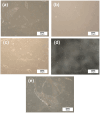Investigating the Mechanisms of Discoloration in Modern Dental Materials: A Comprehensive Characterization Approach
- PMID: 39330222
- PMCID: PMC11432760
- DOI: 10.3390/jfb15090246
Investigating the Mechanisms of Discoloration in Modern Dental Materials: A Comprehensive Characterization Approach
Abstract
In general, patients' opinions on reaching ideal esthetics while restoring dental tissues is one of the most important part of the oral treatment. Unfortunately, discoloration of dental materials may occur due to intrinsic and extrinsic factors. The aim of the study was to evaluate the color stability of frequently used dental resin materials and determine the mechanism of their discoloration. The study used various characterization techniques (optical microscopy, Fourier-transform infrared spectroscopy, low-temperature N2 adsorption, diffuse reflectance spectroscopy, and luminescence) to understand the effect of surface defects on discoloration. The adsorption of model liquids on the surface was confirmed to be related to the increase in BET surface area. The study found that the adsorption of discolorants, such as coffee, tea, and wine, on the surface of the dental material follows the multilayer BET model. When the surface is smooth, the discoloration is usually within acceptable limits, with a maximum of ∆E = 3.3. The discoloration made by tea and demineralized water was within acceptable limits even after 7 days of exposure.
Keywords: color parameters; dental composite; optical microscopy; surface defects.
Conflict of interest statement
The authors declare no conflicts of interest.
Figures





Similar articles
-
Staining of resin-based veneering materials with coffee and tea.Quintessence Int. 1991 May;22(5):377-86. Quintessence Int. 1991. PMID: 1924691
-
Effects of different drinks on stainability of resin composite provisional restorative materials.J Prosthet Dent. 2005 Aug;94(2):118-24. doi: 10.1016/j.prosdent.2005.05.004. J Prosthet Dent. 2005. PMID: 16046965
-
Discoloration of coating resins exposed to staining solutions in vitro.Dent Mater J. 2009 May;28(3):338-43. doi: 10.4012/dmj.28.338. Dent Mater J. 2009. PMID: 19662733
-
Comparative Evaluation of the Discoloration of Microhybrid and Nanohybrid Composite Resins by Different Beverages: A Spectrophotometric Analysis.J Contemp Dent Pract. 2019 Feb 1;20(2):226-230. J Contemp Dent Pract. 2019. PMID: 31058640
-
Effect of resin surface sealers on improvement of stain resistance for a composite provisional material.J Esthet Restor Dent. 2003;15(4):244-9; discussion 249-50. doi: 10.1111/j.1708-8240.2003.tb00292.x. J Esthet Restor Dent. 2003. PMID: 12948218
Cited by
-
Color stability, surface roughness, and surface morphology of universal composites.Odontology. 2025 Apr 28. doi: 10.1007/s10266-025-01108-2. Online ahead of print. Odontology. 2025. PMID: 40293627
-
A Comparison of Internal, Marginal, and Incisal Gaps in Zirconia Laminates Fabricated Using Subtractive Manufacturing and 3D Printing Methods.Biomimetics (Basel). 2024 Nov 28;9(12):728. doi: 10.3390/biomimetics9120728. Biomimetics (Basel). 2024. PMID: 39727732 Free PMC article.
-
Tooth discoloration caused by nanographene oxide as an irrigant and intracanal medicament in the endodontic treatment of extracted single-rooted teeth: An ex-vivo study.PLoS One. 2025 Jun 26;20(6):e0325430. doi: 10.1371/journal.pone.0325430. eCollection 2025. PLoS One. 2025. PMID: 40569948 Free PMC article.
References
-
- Knispel G. Factors Affecting the Process of Color Matching Restorative Materials to Natural Teeth. Quintessence Int. 1991;22:525–531. - PubMed
LinkOut - more resources
Full Text Sources

